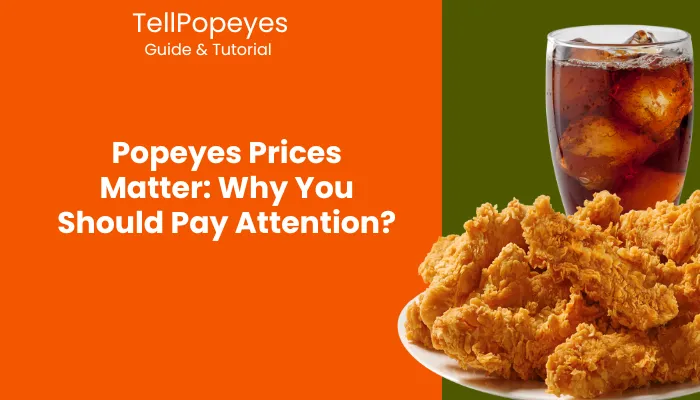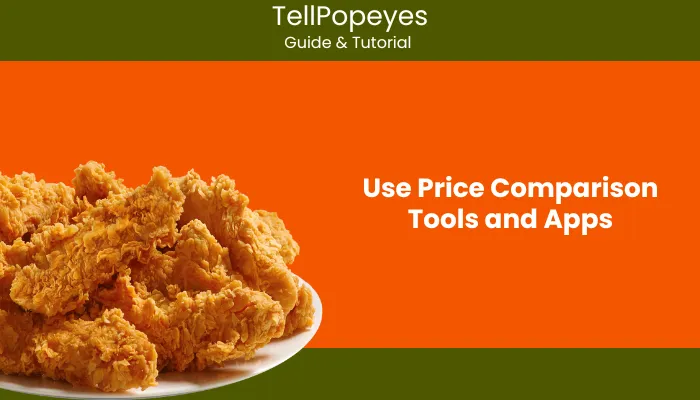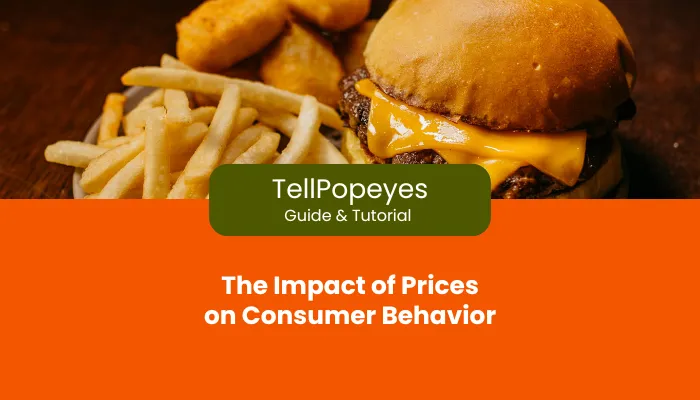Curious about Popeyes prices and what drives them? Whether you’re grabbing a quick combo meal, hunting for app-exclusive deals, or comparing costs across food delivery platforms, understanding how pricing works at Popeyes can help you make smarter dining decisions.

This guide breaks down everything, from how prices are set, to the psychology behind value meals, to real-world examples and savings strategies. You’ll also learn how customer feedback from platforms like TellPopeyes can reveal insights about menu value and satisfaction. Dive in and discover what those menu numbers really mean for your wallet.

Popeyes Prices Matter: Why You Should Pay Attention?
Curious about the numbers on your receipt? This section explores what prices are and why they’re a big deal for shoppers and diners alike.
At its core, prices represent the cost you pay for goods or services, like a Popeyes chicken sandwich or a new pair of shoes. They’re the monetary value businesses assign based on factors like production and demand. For example, Popeyes prices reflect the quality of their spicy recipes and quick service, giving you a sense of what you’re getting for your money.
- Basic Concept: The amount charged for a product or experience.
- Examples: From $5 fast-food combos to $50 premium items.
- Variation: Prices shift based on location, brand, or promotions.
Why Prices Matter to You
Understanding prices isn’t just about budgeting, it’s about value. They shape how you perceive quality, decide where to eat, or what to buy. High Popeye’s pricing might signal fresh ingredients, while lower ones could mean a deal. Prices also affect your daily choices and long-term habits.
- Affordability: Helps you stay within your budget.
- Value Perception: Ties cost to customer satisfaction (e.g., “Was that meal worth it?”).
- Market Insight: Reflects trends like inflation or competition.
Prices are more than numbers, they’re a bridge between businesses and customers. Whether you’re eyeing Popeyes cost or comparing grocery costs, knowing their role empowers you to spend smarter and get the most bang for your buck!
Market conditions and pricing
Ever wonder why costs vary from one place to another? This section uncovers the key factors that shape prices, including those tasty Popeyes prices you see on the menu.
Core Factors Behind Pricing
Several elements determine what you pay, whether it’s a burger or a service. These factors help businesses like Popeyes set prices that balance profit and appeal. Here’s what drives them:
- Production Costs: Ingredients, labor, and packaging add up. For Popeyes cost, think spicy chicken and biscuit prep.
- Competition: Nearby rivals can push prices down or up to stand out.
- Location: Urban spots often charge more than rural ones due to rent and demand.
- Seasonality: Prices might rise with ingredient shortages (e.g., holiday poultry spikes).
How These Factors Play Out
Let’s break it down with examples. The table below shows how these factors tweak Popeye’s pricing or similar fast-food costs:
| Factor | Example Impact | Effect on Prices |
|---|---|---|
| Production Costs | Higher chicken prices from suppliers | Increases menu costs |
| Competition | A new fried chicken joint opens nearby | May lower prices to compete |
| Location | City vs. small-town Popeyes | Higher in cities |
| Seasonality | Thanksgiving demand for poultry | Temporary price hike |
Real-World Note: A Popeyes in New York might charge more than one in a small town due to rent alone.
Why It Matters to Businesses and You
These factors aren’t random, they reflect market trends and supply-demand dynamics. For Popeyes, keeping prices fair ensures customer satisfaction while covering costs. For you, it’s a peek into why that combo meal costs what it does.
Understanding these influences helps you see the story behind every price tag, from Popeyes prices to your grocery bill, so next time, you’ll know what’s at play!
Types of Prices You’ll Encounter
Prices come in many forms, depending on the product, industry, or even customer. Understanding the different types of prices you encounter daily, whether shopping online or reviewing Popeye’s pricing on a menu, can help you make smarter choices and recognize the value behind the numbers.
Fixed Prices vs. Dynamic Prices
Most commonly, prices fall into two broad categories:
Fixed Prices
- Set and non-negotiable.
- Common in retail, fast-food restaurants, and online stores.
- Example: A combo meal at Popeyes listed at $9.99 is a fixed price.
Dynamic Prices
- Change based on demand, availability, or customer behavior.
- Used in industries like travel, hospitality, and ride-sharing.
- Example: Airfare prices fluctuate depending on the season and time of booking.
Here’s a comparison table summarizing different types of pricing models across industries:
| Price Type | Description | Common In | Example |
|---|---|---|---|
| Fixed Price | Stable and unchanging | Fast food, retail | Popeyes prices on the menu |
| Dynamic Pricing | Varies based on real-time factors | Airlines, e-commerce | Hotel rates, Uber fares |
| Promotional Price | Temporary discount or offer | Retail, food service | Limited-time meal deals |
| Subscription Price | Recurring cost over time | SaaS, streaming services | Netflix, Spotify |
| Tiered Pricing | Levels based on quantity or features | Software, memberships | Bronze/Silver/Gold plans |
This table helps clarify how different pricing strategies are used across sectors and how they may impact your spending choices.
Retail, Wholesale, and Service-Based Pricing
Not all pricing is structured the same across industries. Here’s how pricing varies depending on context:
Retail Pricing
- What you pay as a consumer.
- Includes profit margin for the seller.
Wholesale Pricing
- Lower prices offered to businesses or bulk buyers.
- Not usually available to regular consumers.
Service-Based Pricing
- Based on time, expertise, or package tiers.
- Example: A marketing agency might charge $500/month for content strategy.
Below is a quick comparison of these pricing types across buyer categories:
| Pricing Type | Buyer Type | Price Example |
|---|---|---|
| Retail | End consumer | $6.99 for a sandwich at Popeyes |
| Wholesale | Businesses | $400 for a case of products |
| Service-based | Clients/customers | $100/hr consulting fee |
Knowing whether a price is set for individuals, businesses, or based on time and value helps you understand what you’re really paying for.
prices come in many shapes and strategies, each one tailored to match buyer behavior, market conditions, or product type. Recognizing these variations helps you make informed choices, whether you’re comparing streaming subscriptions or checking the latest Popeyes prices before placing an order.

Use Price Comparison Tools and Apps
In today’s digital world, comparing prices manually is no longer your only option. With the help of modern price comparison tools, you can easily spot the best deals on everything, from electronics to fast food items like Popeyes prices.
These tools are designed to save you time and money by collecting pricing data across different platforms and showing you the most cost-effective choice.
Best Price Comparison Tools You Can Use
Below is a table outlining popular tools to track and compare prices effectively:
| Tool | Best For | Key Features |
|---|---|---|
| CamelCamelCamel | Amazon product pricing | Historical price charts, price drop alerts |
| Honey | Coupon codes + comparisons | Automatically applies best coupons at checkout |
| PriceRunner | Retail price comparison | Side-by-side pricing from multiple online stores |
| Trivago | Hotel pricing | Compares prices across booking platforms |
| DoorDash / Uber Eats | Food delivery services | Check updated Popeyes prices with delivery fees |
These tools work behind the scenes to give you real-time price insights, helping you avoid overpaying.
Mobile Apps That Track Popeyes Prices
For fast food lovers, especially fans of Popeyes, checking updated Popeyes costs via Popeyes apps is crucial. Here are a few apps worth installing:
- Popeyes App
- Get exclusive deals, digital Popeye coupons, and updated menu pricing
- Earn loyalty points for future discounts
- DoorDash / Uber Eats
- View prices with delivery charges and service fees
- Compare with in-store or pickup pricing
- TellPopeyes Survey Site
- Read real customer feedback on whether the price matched the value
- Check for trends in satisfaction and pricing
These platforms provide transparency on pricing and help you decide whether to order via delivery or dine-in for the best value.
Tips to Maximize Savings While Comparing Prices
Use these expert tips when using tools or apps for price comparison:
- Bookmark comparison sites you use often
- Enable price drop notifications for favorite items
- Check both in-store and app-only deals
- Don’t forget about hidden costs like service fees or tips
With the right strategies and tools, you’ll always know whether you’re getting the best deal, especially when checking something like Popeyes prices on different platforms.
Price comparison tools and apps make it easier than ever to shop smart. From spotting the lowest tech deals to understanding fluctuations in Popeyes cost, they equip you with the insights needed to make informed purchases. Start using them today, and watch your savings grow, one smart comparison at a time.
How to Compare Prices Effectively
In a world filled with endless buying options, learning how to compare prices smartly can save you money and help you get the best value for your budget. Whether you’re grocery shopping, booking a service, or checking Popeyes prices before ordering lunch, smart comparison ensures you’re not overspending for the same value.
Key Steps to Compare Prices the Right Way
Use these simple yet effective steps to evaluate prices across platforms, stores, or brands:
1. Define Your Priorities
- Are you looking for lowest price, best quality, or value for money?
- This helps narrow down options that meet your needs.
2. Check Multiple Sources
- Compare prices on:
- Retail websites
- Food delivery apps
- Official brand websites (like the official Popeyes menu)
- In-store prices
3. Watch for Hidden Costs
- Look for:
- Delivery fees
- Taxes
- Tipping or service charges
- Upsells (e.g., meal add-ons)
For example, Popeyes prices on food delivery apps may include additional service fees compared to ordering directly from the store.
4. Use Price Comparison Tools and Apps
- Leverage tools that aggregate prices:
- Google Shopping
- Honey or Capital One Shopping
- PriceRunner
- Trivago (for travel)
- Instacart or DoorDash (for food)
5. Take Advantage of Loyalty Programs & Coupons
- Sign up for:
- Email offers
- Popeyes rewards points
- First-time order discounts
Many fast-food chains, including Popeyes, offer mobile app deals and digital coupons that reduce total spend.
Price Comparison Table Example
Here’s a real-world comparison of pricing methods across different platforms for a fast-food item (e.g., chicken sandwich combo):
| Platform | Base Price | Delivery Fee | Service Charge | Total Price |
|---|---|---|---|---|
| In-Store | $7.99 | $0 | $0 | $7.99 |
| Popeyes App | $7.99 | $0 (pickup) | $0 | $7.99 |
| Uber Eats | $7.99 | $2.99 | $1.50 | $12.48 |
| DoorDash | $7.99 | $2.49 | $1.99 | $12.47 |
This shows that while the base price (like Popeyes prices) may remain the same, the total cost varies widely depending on the platform.
Bonus: Tips to Spot the Best Deal
- Compare price per unit (useful in groceries or bulk buys).
- Don’t be swayed by discounts alone, consider quality.
- Read reviews to validate if higher price = better product.
- Watch for recurring charges on subscriptions or delivery plans.
knowing how to compare prices helps you stretch your budget, avoid overpaying, and make confident purchasing decisions. Whether you’re evaluating Popeyes prices across apps or shopping for electronics, following a clear comparison strategy ensures you get the most value for your money.

The Impact of Prices on Consumer Behavior
Prices don’t just reflect the cost of a product, they shape how we think, feel, and buy. From sparking excitement over a deal to making us question a product’s quality, pricing plays a powerful psychological role. In this section, we’ll explore how different types of pricing influence consumer behavior, including the effects seen in Popeye’s pricing and fast-food buying habits.
How Pricing Affects Purchase Decisions
Consumers don’t always choose the cheapest item, they choose what feels like the best value. Here are some common pricing influences:
1. Price Perception
- A $4.99 item often feels cheaper than a $5 item.
- Called “charm pricing”, this tactic boosts conversions.
- Common in fast food, retail, and e-commerce.
2. Price Anchoring
- Showing a higher original price next to a discount makes the new price seem like a better deal.
- Example: “Was $10.99, now $7.99!”
- Seen frequently in Popeyes prices for limited-time offers and combo deals.
3. Brand Loyalty vs. Bargain Hunting
- Some consumers stick to familiar brands despite higher costs.
- Others jump ship when a competitor offers a better deal.
- Brands use loyalty programs to keep regular customers returning.
Psychological Effects of Pricing
Prices also trigger emotional and psychological responses that can alter buying behavior:
| Pricing Tactic | Effect on Consumer | NLP Keywords |
|---|---|---|
| Charm Pricing ($9.99) | Perceived as a “deal” or “under $10” | affordable feel, price perception |
| Bundle Pricing | Increases perceived value for multiple items | value meal, combo offer, meal deal |
| Scarcity Pricing | Encourages urgency (e.g., limited-time offers) | flash sale, limited menu item, deal time |
| Premium Pricing | Suggests exclusivity and high quality | luxury feel, premium menu, brand value |
Understanding these pricing tactics helps explain how Popeyes subtly influences perception, value, and the urge to buy, all through strategic price cues.
Fast Food Example: Popeyes Pricing and Behavior
Let’s take a real-life look at Popeye’s pricing:
- A $5 box combo may seem like a great value, especially when compared to a higher-priced meal at a competitor.
- Limited-time offerings, like their Ghost Pepper Wings, create urgency and drive impulsive purchases.
- Frequent app users tend to return due to perceived savings and exclusive digital-only pricing.
These tactics show how Popeyes prices are strategically set to influence consumer habits, encourage trial, and build repeat visits.
Price isn’t just a number, it’s a powerful driver of behavior. From psychological pricing tricks to brand loyalty, understanding the impact of prices helps you become a more informed and intentional shopper.
Frequently Asked Questions
People often have questions about Popeye’s pricing, especially when it comes to menu updates, deals, and regional differences. Below are some of the most frequently asked questions that can help you better understand how pricing works at Popeyes and what to expect when you visit.
What is the average price of a meal at Popeyes?
A typical combo meal at Popeyes ranges from $7 to $11, depending on your location and meal size. Prices may vary slightly by region.
How much does a Popeyes Chicken Sandwich cost?
The classic or spicy chicken sandwich usually costs around $4.50 to $5.50, with combo options available for a few dollars more.
Does Popeyes offer family meals or bulk pricing?
Yes, Popeyes has family meals that typically include 8 to 16 pieces of chicken with sides and biscuits. Prices usually range from $20 to $35.
Are there any value menu options at Popeyes?
Yes, Popeyes often features value deals and limited-time offers under $6. Check the app or website for current promotions.
How can I save money on Popeyes orders?
Use digital coupons, join the Popeyes Rewards program, and look for special combo deals or limited-time offers in the app.
Conclusion
Understanding prices goes beyond just looking at the numbers, it’s about recognizing value, comparing options wisely, and making smart spending decisions. Whether you’re analyzing fast food costs like Popeyes prices or shopping for everyday items, knowing what drives pricing helps you get more for your money. Use tools, track trends, and don’t forget to check platforms like TellPopeyes for real customer feedback on pricing and satisfaction. Smarter spending starts with informed choices.
